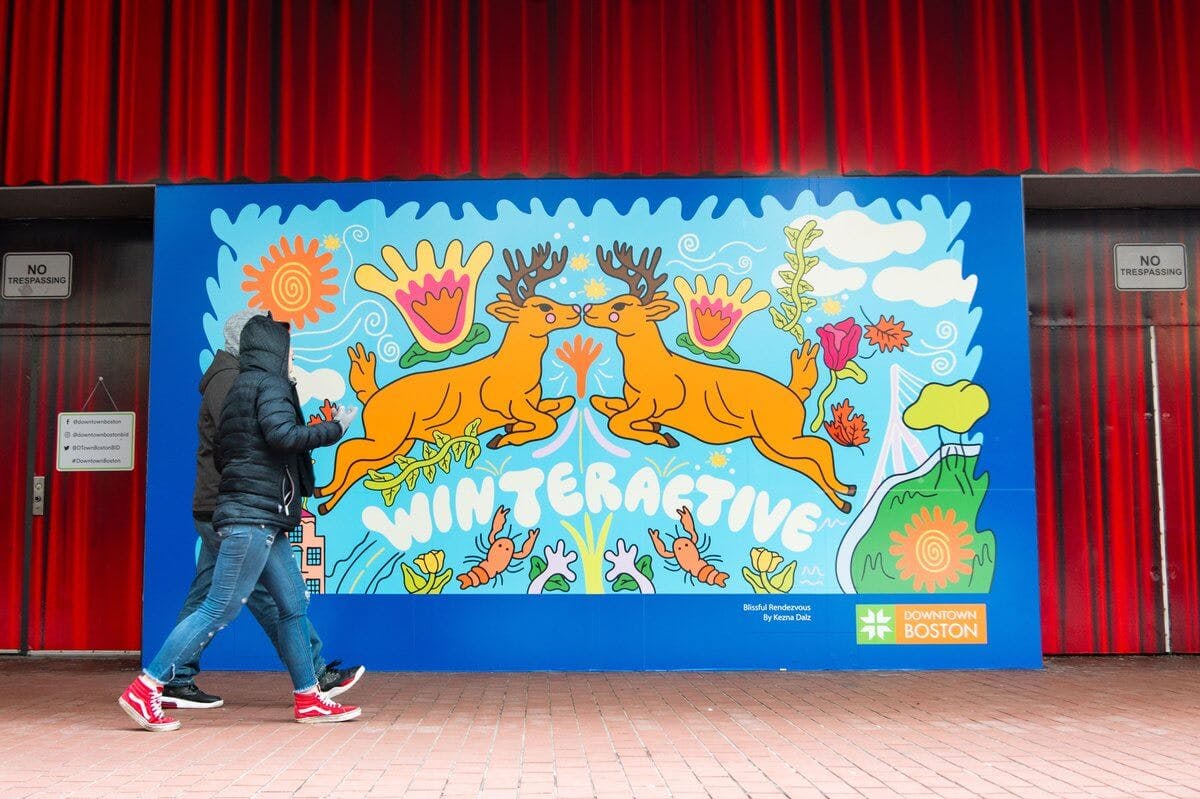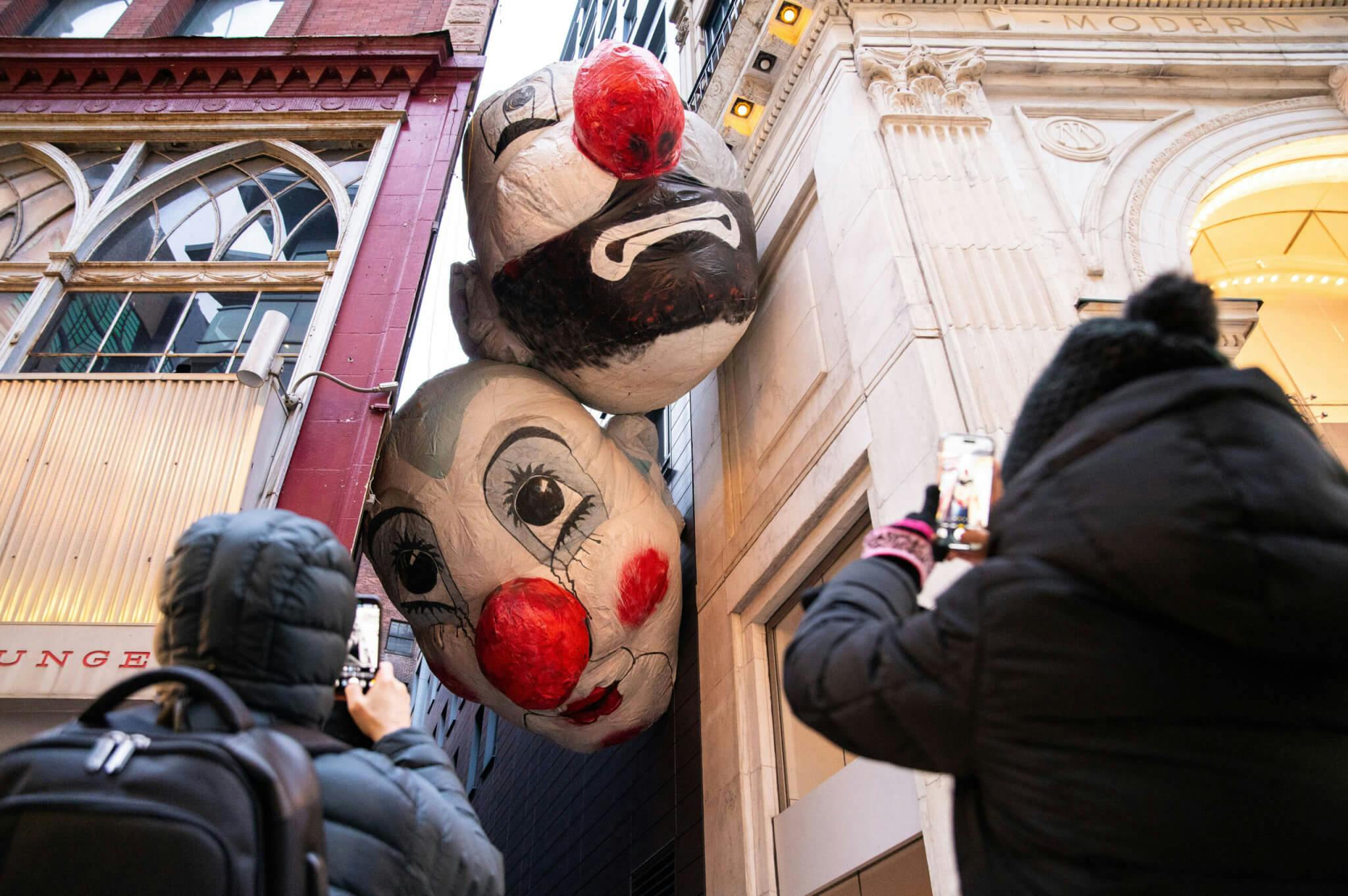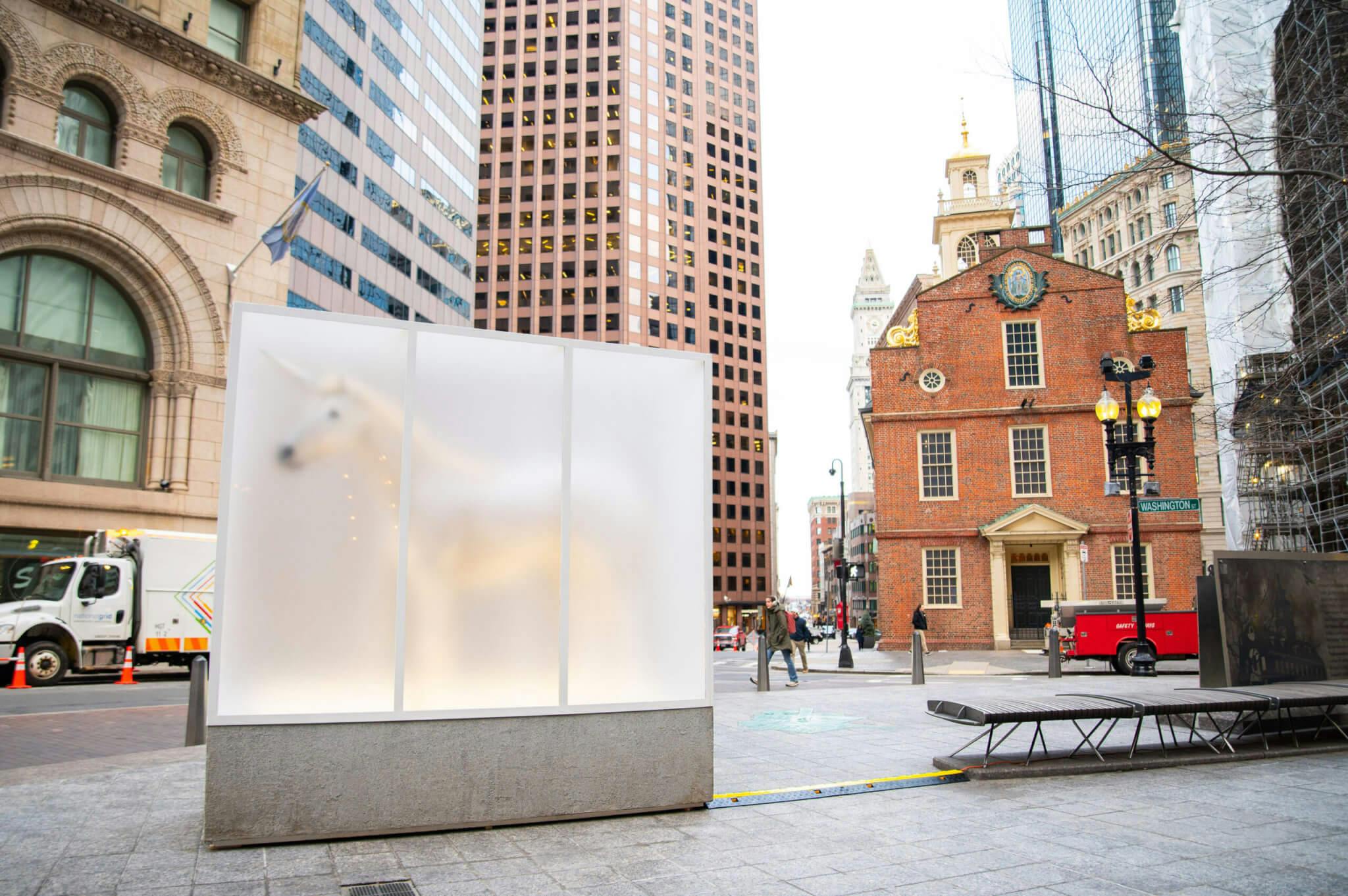A lifelike sculpture of a hooded figure perched on top of the Old Corner Bookstore in Downtown Crossing prompted a concerned call to Boston Fire Department on Sunday afternoon. Firefighters removed the figure, who was holding a fishing pole with a bright red heart dangling at the end of the line. BFD certainly didn’t give him any love and it’s uncertain whether Bostonians were ready to bite either.
The figure is among four others in a series of works called Untitled by Mark Jenkins, an artist who has shown variations of these macabre sculptures in cities around the world. A girl sits slumped on a swing high above the intersection of Winter and Tremont streets while another is perched in an unnatural upside-down position against the awning at 60 Temple Place. They’re part of the Downtown Boston Business Improvement District’s (BID) public art installation “WINTERACTIVE,” opening on January 17 at sixteen different locations across downtown.
Across social media, the figures are being called out for being “jarring,” “creepy,” and “upsetting.” But for Michael Nichols, who joined as president of the Downtown BID in 2022, they’re fulfilling their role of being a conversation-starter for anyone passing through the area. “I see it more as playful. It shouldn’t take someone long to realize it’s not actually a human in this uncomfortable position,” he asserted.
Jenkins’s sculptures and all of the other works in the “WINTERACTIVE” presentation were installed with the goal of getting more people to interact with the downtown area during the winter months—hence the name—and will be on view through Boston Marathon Weekend in April.
While the twelve-year-old organization’s first attempt at a widespread public art installation has certainly attracted attention, the flashiness, scale, and shock factor feels to be at the expense of fostering genuine connections with the communities already in Boston’s downtown. The one-hundred-acre area that the BID oversees borders Chinatown, the Financial District, and Beacon Hill. It also includes the St. Francis House shelter—the largest day shelter in Massachusetts—which serves up to five hundred individuals a day. I suppose this might contribute to the uneasy feeling of seeing Jenkins’s sculptures slumped in uncomfortable positions. At a glance, they might resemble a community member in need of help.
No piece of public art is ever going to please everyone—just look to the responses after The Embrace was unveiled almost exactly a year ago on Boston Common—but with “WINTERACTIVE,” it appears as though commerce and tourism were more important than presenting artworks that might establish a strong sense of place, connection, or dialogue for the communities that already frequent downtown.
Upside-down figures aside, the entire installation feels a bit out of place, and that’s because it is. The project is largely supported by Meet Boston (formerly known as the Greater Boston Convention & Visitors Bureau) and the City of Boston’s tourism office. The installation is presented in partnership with the Quebéc government, which became most obvious with an interpretive text in front of the Downtown Crossing stairs presented in English and French. The curators behind the project all hail from the Canadian province too: EXMURO Arts Publics from Québec City and LeMonde Studio and Quartier des Spectacles International from Montréal.
“Canadians are pros at winter,” Nichols affirmed as we walked through downtown on a blustery Martin Luther King Jr. Day without the usual buzz of commuters. “Where Boston’s public art projects usually disappear in the colder months, Canadians are producing festivals all winter long. We wanted to give Bostonians a taste of what winter in Québec is like,” he said.
Most of the artworks have been previously on view in outdoor festivals across Canada, with the exception of a digitally created “mural” by Canadian artist Kezna Dalz commissioned by the Downtown BID. The large vinyl features a mashup of Boston and Canadian iconography in bright blues and pinks: reindeer mid leap, snowflakes, the Zakim bridge, and, you guessed it, maple leaves and lobsters. It’s cute, but feels like an advertisement, and I suppose that’s because it is.
No matter how offensive or inoffensive the installations are, Nichols’s plan is working: People are coming downtown.
Nestled in a quintessential downtown alley between Suffolk’s Modern Theatre and the building that formerly housed the Felt nightclub, giant looming clown heads titled Endgame: Nagg & Nell by artist Max Streicher caused an online frenzy over the long weekend. “We came in from Winthrop after reading about the controversies with the artwork,” a man shared after asking us to snap a photo of him and his daughter. “I think they’re fantastic,” he said.
“It’s encouraging to see people flocking downtown on the coldest days of the year,” said Kate Gilbert, executive director of Now + There, whose organization is planning a city-wide series of temporary public art installations in 2025. “Public art can provoke, which Mark Jenkins’s works are certainly doing, bring us together, as I saw watching ATOMIC3’s fire pit when it was first exhibited, and affirm values,” Gilbert shared.
While Bostonians are being offered a glimpse of “winter in Québec,” Boston still has a long way to go in establishing its reputation as a public art city. Importing one from somewhere else might not be helping the cause.
Now + There is among many local organizations that are dedicated to creating more opportunities for engaging with public art and are doubling down on their commitment to featuring work by Boston-area artists—especially BIPOC artists, of which “WINTERACTIVE” features only one. The Rose Kennedy Greenway, the Emerald Necklace Conservancy, Street Theory, and the Esplanade Association have all presented a mix of internationally renowned artists alongside local artists. Of course, it takes a careful balancing act to support local artists without slipping into provincialism—one that takes several years and a lot of community engagement work to master.
There’s something to be said for making such a sprawling installation happen so swiftly, especially in a city where permitting, public meetings, and approvals can make siting art on public spaces extremely difficult. The planning for “WINTERACTIVE” began in the fall, according to Nichols, who spearheaded the project and worked with business owners from within the BID’s network to use their properties as destinations for the works. Nichols is no stranger to large-scale projects and has previously held high-level positions at both the Rose Kennedy Greenway and the Esplanade Association.
“I’m excited that the BID is venturing into public art and for them to continue to explore siting public art installations to enliven Downtown Boston, especially through commissioning local artists for site-specific pieces in the future,” shared Karin Goodfellow, director of public art for Boston’s Office of Arts and Culture. “I think this series is a promising first step to build upon,” she said.
“I do think there could have been ways for us to engage with local artists,” Nichols said. “But we’ve done nothing but local art for twelve years,” he continued, pointing to the painted electrical boxes on Summer Street. “This was a way for us to launch a broader profile.”
Nichols affirms that partnerships with local organizations will definitely be on the horizon as he settles into his position at the BID. In the meantime, we’re stuck with a hodgepodge of pedal-powered light-up structures, a guitar-shaped slide on City Hall Plaza, a smattering of disconcerting figures, and a giant interactive whale. Public art in Boston doesn’t always need to be by Boston artists, but it should at least be for Boston audiences. Needless to say, when it comes to Canadian clowns, I’ll stick to Cirque du Soleil.
“WINTERACTIVE” is on view at locations across Downtown Boston January 17 through April 15. Information about the works on view and upcoming programs can be found on the WINTERACTIVE website.




